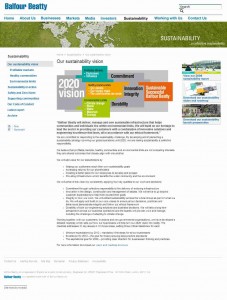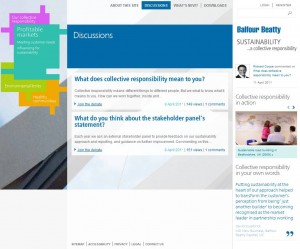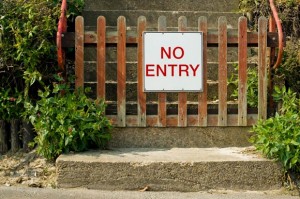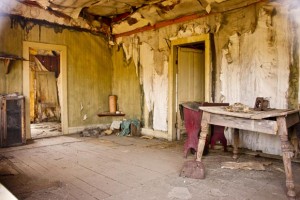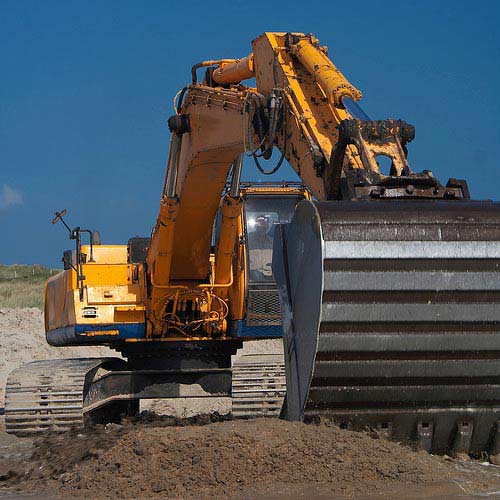 In these straitened times it is perhaps unsurprising that the construction sector is a little more down on its uppers than usual. Because of this, Balfour Beatty aren’t actually in the FTSE100. At present. They’ve been in and out like a yoyo the last couple of years and are currently out.
In these straitened times it is perhaps unsurprising that the construction sector is a little more down on its uppers than usual. Because of this, Balfour Beatty aren’t actually in the FTSE100. At present. They’ve been in and out like a yoyo the last couple of years and are currently out.
However, for the purposes of this post, I’m going to pretend it’s 2009 all over again, and they’re in.
Balfour Beatty’s sustainability web offering falls into three bits: Sustainability on the main site, the current Sustainability report (2010), and the microsite for that report.
Taking the offerings in that order…
The main Sustainability site
This is accessed from the top menu bar throughout the company’s main site. Subsections are accessed from the left hand column, most of which expand into three or four subsections. In addition three or four relevant shortcuts are presented in the right hand column.
I have to say I’m not overly taken by either the navigation or the colour scheme .. it works but doesn’t feel particularly slick or well thought out.
However there are some great points to this website. One of them is the company’s transparency in terms of governance: on the Code of Conduct page, gathered together from a few places, are links to a variety of the company’s policies, ranging from risk management through human rights to data protection.
Another is the multimedia content in their case studies. These are nice and straightforward, yet thoroughly engaging and informative. Each has a flash picture with hotspots giving you key points, and on two of the three there is also video to watch.
The Sustainability Report
It’s not my usual practice to comment heavily on companies’ actual reports, mainly because their content has little to do with this blog’s main focus: websites. However there are two aspects which are worth drawing out:
Lowlights and Highlights: The report is very strong on revealing the “bad” side of the company as well as the “good”. This isn’t just in terms of a traffic light system for the company’s KPIs, but also in terms of the commentary which surrounds it.
For example, Balfour Beatty have a Zero Harm campaign, through which they aim to have zero fatalities and disabling injuries by 2012. They were fined nearly £39,000 for workplace health and safety in 2010, nearly three times the 2009 figure. Neither figure had to be included in the report.
A further example is including their exclusion from the Dow Jones Sustainability Index during 2010. There’s no reason to include this, other than a desire to be honest and transparent; reporting the news, whatever it may be.
Stakeholder panel: The report also includes a report from the company’s Stakeholder panel, a response from the company and progress against the 2009 stakeholders’ recommendations. They key aspect here is not just that the company has set up stakeholder panel, which a growing number are starting to do, but that it’s prepared to have disagreements with them in public.
For example, there is currently a disagreement between whether Balfour Beatty’s senior management should be paid according to sustainability achievements. The stakeholder panel want them to be, the remuneration committee disagrees.
The Sustainability report microsite
Based on the 2010 report, this is basically an online version of the company’s summary report without all the data, traffic lights and discussion.
This is a shame. I truly believe companies are missing a trick by not putting their data online and missing an even further trick by not making the data queriable or even real time. This is, in my opinion, more a triumph of conservatism over technology than anything else.
There is, however, one aspect of the microsite which is revolutionary: discussion.
A major part of the site is the ability for stakeholders to engage with management in discussions. The senior managers pose questions such as “What do you think about the stakeholder panel’s statement?” and you’re invited to respond (but yes, you have to be registered to do so).
This is really wonderful and not only do I hope Balfour Beatty decide to keep going with the initiative but that others decide to mimic it and take it one step further. After all, if you’re going to publish your report online and let people comment, when not let them comment on the report itself?
Building for the future
There is much to praise and much which is surprising about the sites. They do lack a certain clarity and coherance which comes mainly from the slightly confusing navigation, but there is more than enough innovation and insight to make up for this.
Balfour Beatty are currently on a long sustainability journey. They first set off on EHS in 2004, converting to CSR in 2006 and sustainability in 2009. The 2009 vision includes a roadmap all the way through to 2020, the first set of milestones for which will be reported against in 2012, and the next set in 2015.
If they continue to revolutionise and innovate for these years as they obviously have done since 2009, they could well become one of the leading sustainable construction lights in the world.
Picture Credit: Digger – FGS Plant Hire by Terinea IT Support under Creative Commons Attribution License.
What do you think about the stakeholder panel’s statement?
A former CTO, Chris has a broad and varied background. He’s been involved with blue chips, consultancies & SMEs across a wide variety of sectors and has worked in Europe, the Middle East and Australia.
In 2007 he decided to combine his knowledge of business and IT with his passion for all things sustainable and has been busy writing ever since. However, his greatest ambition remains to brew the perfect cup of coffee.
